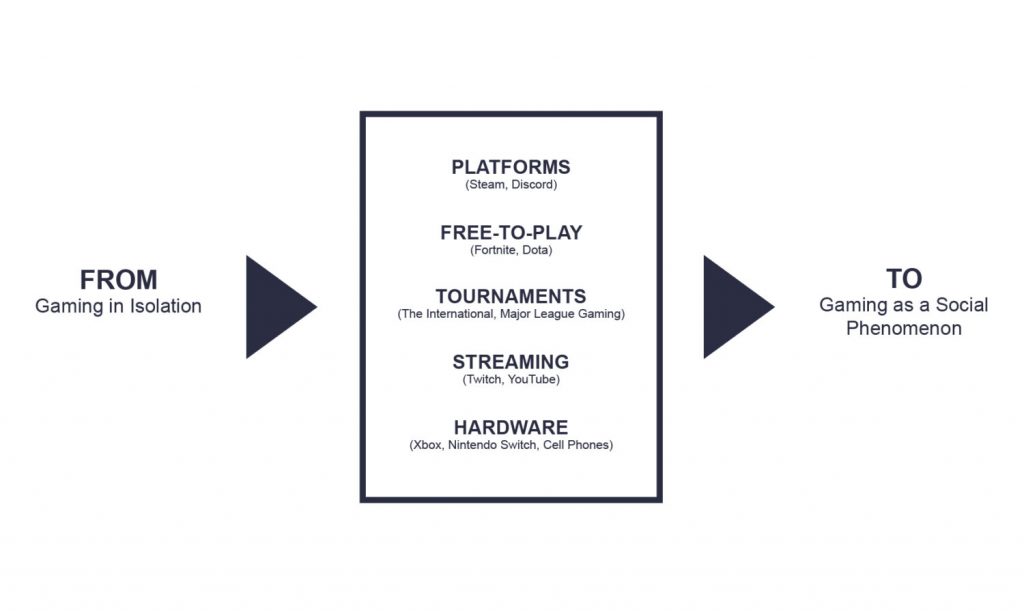Rob Dickens & Stacey KaufmanPartner, Global Strategy Director & Associate Strategy Director
Gaming communities are the new borderless, global cities, and brands need to start investing in them as if they were New York, London, or Tokyo.
Gamers make up over a third of the global population – nearly 67% of Americans and 46% of the Chinese population. These communities fit the definition of megacities; a large human settlement of more than 10 million people.
In this case, however, the city borders aren’t defined by location, but shared interests. In essence, gamers are residents of the games they inhabit and travel between. Together they are building digital cities, each with a set of rich and diverse cultural norms and rituals.
The architects – Tencent, Nintendo, Activision Blizzard et. al. – build each city jam-packed with fantastical landmarks and intrepid journeys for players to explore and experience, all the while seamlessly integrating the ability to shop at the click of a button.
These digital cities have evolved into large, important cultural centers. In the past two decades, we’ve moved from gaming in isolation to gaming as a social phenomenon. What was once seen as a sub-cultural hobby or something only reserved for basement-dwelling “nerds” has become a mainstream badge of cultural clout. Gaming is now culture, community, identity, fashion, music, technology, and sport all in one powerful medium.

Today we’re more likely to find community connections logging into a game than physically walking through Manhattan. Which was exactly what happened with YBN, a rap group who met while freestyling over Grand Theft Auto, only meeting in person after they had notched their first Billboard Top 100 hit. And that was before the pandemic.
In 2020, the global gaming population grew by around 150MM – more people than there are in the whole of Russia. While cities shut down and borders were closed all around the world, borderless digital cities flooded with new citizens. Likewise, as physical stores stayed closed, digital shopping registers rang out to the tune of $160bn in global gaming revenue – a number larger than the GDP of 75% of the countries in the world. The gaming industry has already outgrown the revenue of both the music and movie industries and based on current CAGR forecasts it will overtake the sports industry by 2035. Yet, despite people spending 4x the amount of time on games than on TV, advertisers have been slow to shift investment, with 40x less money going to gaming.
Gaming has become the new frontier for virtual experiences, and as the limits of this evolving technology are pushed further and further, so too are the limits of what’s possible for brands. In a medium where attention is palpable and experience design possibilities only stop when your imagination stops, we’ve only just begun to see what can be achieved with this advertising medium.
To help brands navigate this new world, we’ve outlined three key avenues for activation:
- Communication
- Entertainment
- Commerce
1 COMMUNICATION
This avenue is a ‘brand talks to gamer’ option, and it is the most popular route because it is lower involvement: creating live streams, sponsoring influencers, events, tournaments, leagues or simply bidding on inventory targeting these interests on platforms or through publishers. A good, highly effective example is Indeed’s partnership with gamer littlesiha and Twitch where they created a piece of short content endorsing Indeed as a jobs site and promoted it natively on her channel and throughout the platform.
2 ENTERTAINMENT
This avenue is where a ‘brand creates an experience for the gamer’. The brand authentically integrates or enhances a gaming experience by creating something unique within the walls of the ‘city landscape’. The Joe Biden x Kamala Harris Campaign executed this well within Animal Crossing, building a custom island in-game for players to visit and learn about their policies. They went on to promote the brand experience via a live-stream event featuring US Democratic party star, Alexandria Ocasio-Cortez. While production costs can sometimes be large for this option, PR potential is larger.

3 COMMERCE
The least explored but also the most directly lucrative avenue is a ‘brand creates buyable value for gamers’ activation, where brands integrate commerce into gameplay. Gamers pay top dollar for digital clothing, accessories and tools for their characters within gameplay. It represents a huge opportunity for brands to start selling branded fashion, beauty and utility products digitally. Not only is this ‘sustainable retail’, but it also has the potential to become a fully-fledged retail category. The Gucci x North Face collaboration leads the way through a virtual capsule collection on Pokémon Go, offering it as a gift to consumers unable to visit stores or access the great outdoors IRL due to COVID-19.

Like any investment, it’s important to do your research. While on the surface, gaming is simply another avenue through which people can seek entertainment it’s also a community with its own customs and etiquette, so infiltrating gaming spaces without being authentic or respectful can quickly cause audience anger or contempt.
As advertisers continue to gentrify these virtual cities it seems likely that gaming will soon become the largest entertainment industry in the world – a digital mega-municipality of the likes we’ve never seen. So, the question is no longer ‘if’ you should include gaming in your plans, it’s ‘how’ – and which of these avenues for activation is right for your brand.


